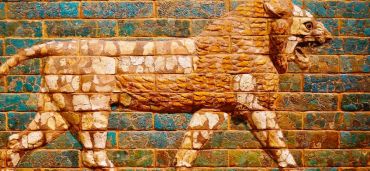Prophetic Assyrian Omens
Predicting Donald Trump’s presidency via sheep entrails must rank among the most unusual exercises in academic outreach ever undertaken. But it is just one way Dr Selena Wisnom has brought her Assyrian research to the wider world.
 The Oriental Institute Museum at the University of Chicago displays art and relics from the Assyrian empire in Mesopotamia, including Lamassu statues
The Oriental Institute Museum at the University of Chicago displays art and relics from the Assyrian empire in Mesopotamia, including Lamassu statuesCredit: Shutterstock / EQRoy
'There are all kinds of things you can understand better if you try it than if you just read about it,' she says – an assertion that any teacher of ovine anatomy would second. She chose political prediction because in Assyria divination was a vital political tool. 'They would ask things like, "Is there going to be a rebellion in the south? Is the chief eunuch going to take the throne?"
'Thinking how would that be used today, I took a question which seemed entertaining at the time – would Trump take the presidency.' She performed the extispicy (from photographs rather than actual innards) on radio, and followed it up by correctly predicting the Macron victory in France – 'a 100% success rate so far', she laughs.
She has also channelled her knowledge of divination into a trilogy of plays about the later rulers of the Sargonid dynasty. Writing the first part, Ashurbanipal: The Last Great King of Assyria, Wisnom drew closely on her academic specialism: Ashurbanipal was a scholar in divination who played his advisers at their own game when they tried to use omens to manipulate his policy decisions. Like the second instalment, Essarhaddon: The Substitute King, it has been staged at Oxford’s Lady Margaret Hall by a specially created company – named the National Theatre of Akkad after the empire that gave birth to both Assyria and Babylonia.
Currently making final touches to the third in the trilogy, The Murder of Sennacherib, Wisnom has also given well-received readings of her plays at Assyriological conferences.
But her ambition is to bring the performances to a wider public in collaboration with museums. ‘We have the Assyrian palaces in the British Museum, and we have sections of relief in museums all around the world. They could be performed in the very places they are set!’
Assyria itself had no tradition of drama, and the historical narrative of these kings is fragmentary. 'From a creative point of view, it’s untapped territory,' says Wisnom. But her motivation would have been well understood by the scribes who recorded the Epic of Gilgamesh on the cuneiform tablets for Ashurbanipal’s library. 'They are just really great stories that deserve to be told. They have all the ingredients of epic tragedy – everything you can find in Shakespeare is in ancient Assyria.'
Assyria has been peculiarly neglected by latter-day writers, though Byron once wrote a play about Ashurbanipal called Sardanapalus – wildly unhistorical. Wisnom’s are surely the only Assyrian dramas ever to feature Japanese Noh theatre stylings and a heavy metal score by a quantum physicist. 'This is one of the wonderful things about collaboration,' says Wisnom. 'I wouldn’t have come up with any of those ideas myself. But these three separate styles came together and worked really well.'
The performances led last year to a three-month Cultural Engagement Fellowship from the Arts and Humanities Research Council for Wisnom to build links between Oxfordshire theatres and the University. Among other consequences, productions at Chipping Norton and at Oxford’s Pegasus Theatre have been able to tap into University expertise, and academics now regularly address discussion groups at the Oxford Playhouse.
Funder: Arts and Humanities Research Council
Article written by John Garth (www.johngarth.co.uk)